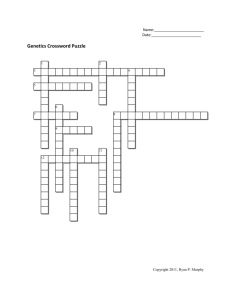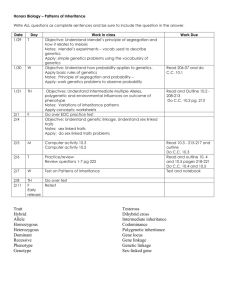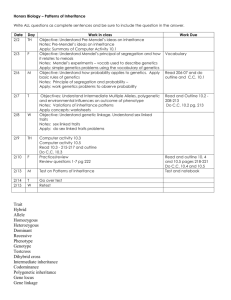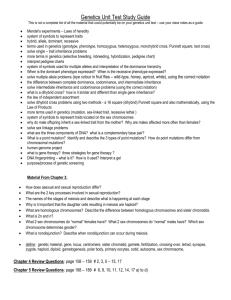Biology 12AP Genetics
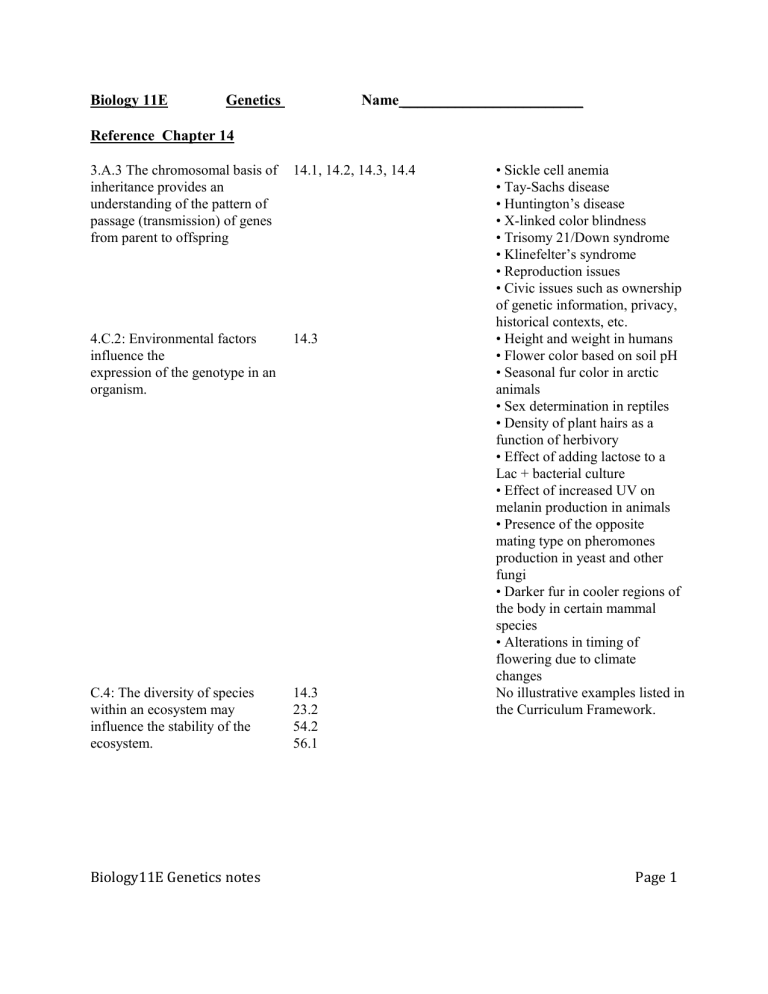
Biology 11E Genetics
Reference Chapter 14
3.A.3 The chromosomal basis of inheritance provides an understanding of the pattern of passage (transmission) of genes from parent to offspring
4.C.2: Environmental factors influence the expression of the genotype in an organism.
C.4: The diversity of species within an ecosystem may influence the stability of the ecosystem.
14.3
14.3
23.2
54.2
56.1
Name ________________________
14.1, 14.2, 14.3, 14.4 • Sickle cell anemia
• Tay-Sachs disease
• Huntington’s disease
• X-linked color blindness
• Trisomy 21/Down syndrome
• Klinefelter’s syndrome
• Reproduction issues
• Civic issues such as ownership of genetic information, privacy, historical contexts, etc.
• Height and weight in humans
• Flower color based on soil pH
• Seasonal fur color in arctic animals
• Sex determination in reptiles
• Density of plant hairs as a function of herbivory
• Effect of adding lactose to a
Lac + bacterial culture
• Effect of increased UV on melanin production in animals
• Presence of the opposite mating type on pheromones production in yeast and other fungi
• Darker fur in cooler regions of the body in certain mammal species
• Alterations in timing of flowering due to climate changes
No illustrative examples listed in the Curriculum Framework.
Biology11E Genetics notes Page 1
Reference Chapter 14
1. Who is the most famous scientist in the field of genetics?
__________________________________________________________
2.
3.
What type of organism did he study to learn about inheritance? ____________________
What was the first major observation that
Mendel made when he crossed two strains of pure-breeding peas and observed a particular characteristic that showed two traits, such as purple and white flowers?
_______________________________
_______________________________
_______________________________
______________________________________________________________________________
_____________________________________________
Biology11E Genetics notes Page 2
Use the Word study tools on the textbook website for chapter 14.
Differentiate between:
A character is an observable heritable feature . and a trait is any detectable variant in a genetic character.
True breeding refers to plants that produce offspring of the same variety when they self-pollinate. and hybridization in genetics is, the mating, or crossing, of two true-breeding varieties .
P generation: The parent individuals from which offspring are derived in studies of inheritance; P stands for “parental.” and F
1 generation: The first filial, or hybrid, offspring in a series of genetic crosses.
F
2
: Offspring resulting from interbreeding of the hybrid F1 generation .
Dominant: An allele that is fully expressed in the phenotype of a heterozygote.
and recessive alleles: An allele whose phenotypic effect is not observed in a heterozygote .
Biology11E Genetics notes Page 3
4. Did Mendel observe the same phenomenon when he looked at other pea characteristics besides flower colour? He observed the same pattern of inheritance (complete dominance) in six other characters, each represented by 2 distinctly different traits.
How did Mendel describe the trait that showed up in the F
1
generation?
________________________________________________________________________
How did he describe the trait that disappeared in the F
1
generation and reappeared in the
F
2
generation? ___________________________________________________________
Biology11E Genetics notes Page 4
See Campbell’s activity 14.1 Monohybrid cross
5.
This box summarizes Mendel’s pea-breeding experiments:
_____________________
_____________________
_____________________
_____________________
_____________________
_____________________
_____________________
_____________________
_____________________
_____________________
_____________________
____________________________________________
Alternative versions of a gene are called ______________________
Where the gene is found on a particular chromosome is called the ______________ for that gene.
Biology11E Genetics notes Page 5
6. What are the four main ideas that make up Mendel’s model to explain inheritance of a single character? (This is also called a single-factor cross . When the F
1
generation are crossed, it is referred to as a monohybrid cross .)
1.
Alternative variations of genes account for variations in inherited characters. (purple flower allele and white flower allele are 2 DNA variations possible at the flower colour locus on one of a pea plants chromosomes.)
2.
For each character an organism inherits 2 alleles, one from each parent.
3.
If the 2 alleles at a locus differ then the dominant allele determines the organisms appearance and the other allele, which is recessive has no noticeable effect on the organisms appearance.
4.
The law of segregation states that when gametes form by meiosis, the 2 alleles will separate into different gametes.
This box illustrates
Mendel’s Law of
Segregation .
_____________________
_____________________
_____________________
_____________________
_____________________
_____________________
____________
Biology11E Genetics notes Page 6
7. Be sure that you understand the following genetics vocabulary:
Homozygous: Having two identical alleles for a given gene .
Heterozygous: Having two different alleles for a given gene.
Phenotype: The physical and physiological traits of an organism, which are determined by its genetic makeup._
___________________________________________
Genotype: The genetic makeup, or set of alleles, of an organism._
This is an illustration of phenotype versus genotype
Biology11E Genetics notes Page 7
Concept 14.2: The laws of probability govern Mendelian inheritance
Campbell’s Activity 14.2 – Gregor’s Garden
8. The Test Cross
How can we use a test cross to determine the genotype of an organism showing the dominant phenotype? (See Campbell’s activity 14A2, 3)
______________________________
We are predicting probabilities. These vary depending on the number of traits in the cross.
______________________________
______________________________
______________________________
Biology11E Genetics notes Page 8
9.
Mendel’s observations of two characteristics at the same time, led to his
Law of
Independent Assortment?
(Campbell’s Activity 14.1: Dihybrid Cross )
He started by asking the question: Will two different characteristics be inherited together as a unit, or independently of each other ?
The diagram below shows the predicted results from the two possible hypotheses:
Which of the two hypotheses was supported by Mendel’s data?
Independent assortment!
_____________________________________________
Biology11E Genetics notes Page 9
Do Concept Check 14.1 p 269
Go to appendix A -10
Biology11E Genetics notes Page 10
10. Alleles segregate into gametes following rules of probability
The expected proportions of offspring genotypes can be calculated following the rules of probability:
______________________________________________________________________________
______________________________________________________________________________
______________________________________________________________________________
Biology11E Genetics notes Page 11
How can we use the two rules of probability to solve more complex genetics problems?
For example:
Solve this problem: In the trihybrid cross, PpYyRr × Ppyyrr, what are the chances that an individual will exhibit at least two recessive traits ?
The first step is to list the genotypes that would result in at least two recessive traits:
The second step is to figure out the probability of each genotype, using the law of multiplication:
The third step is to add together all the different probabilities, using the law of addition:
Concept Check 14.2 p 271
Biology11E Genetics notes Page 12
Degrees of Dominance
11. What is Incomplete Dominance?
Activity 14.3: Incomplete Dominance
The situation in which the phenotype of heterozygotes is intermediate between the phenotypes of individuals homozygous for either allele.
___________________________________
What ratio of phenotypes is expected in the
F
2
generation?
1 red to 2 pink to 1 white.
___________________________________
Biology11E Genetics notes Page 13
12. What is Codominance?
The situation in which the phenotypes of both alleles are exhibited in the heterozygote because both alleles affect the phenotype in separate, distinguishable ways.
Blood Types are a good example of Multiple Alleles AND Codominance:
Human blood has three alleles of a single gene.
The A and B refer to two carbohydrates that may be found on the surface of human blood cells.
Type O has neither carbohydrate.
__________________
__________________________
Biology11E Genetics notes Page 14
In epistasis , a gene at one locus alters the phenotypic expression of a gene at a second locus:
In mice, black coat colour is dominant to brown.
BB is a black phenotype and bb is a brown phenotype.
However a second gene determines whether or not the pigment will be deposited in the hair. The dominant allele, C results in deposition.
cc will result in an albino.
Biology11E Genetics notes Page 15
In polygenic inheritance , more than one gene contributes to the inheritance of a character. There is an additive effect of more than one gene on a single phenotype.
For example, in the inheritance of skin colour, at least 3 different genes are involved. Which individual inherits the darkest skin? _________________The lightest ? __________________
Biology11E Genetics notes Page 16
13. Pleiotrophy the ability of genes to affect an organism in more than one way. eg sickle-cell allele
Biology11E Genetics notes Page 17
2.
3.
When both genetic and environmental factors affect phenotype the characters are referred to as being multifactorial.
Gene expression can depend on environmental factors . For example, in the hydrangea, the colour of the flowers depends on the acidity and aluminum content of the soil:
Concept Check 14.3 p 275
1.
Epistasis: A type of gene interaction in which one gene alters the phenotypic effects of another gene that is independently inherited.
Incomplete dominance: The situation in which the phenotype of heterozygotes is intermediate between the phenotypes of individuals homozygous for either allele.
Biology11E Genetics notes Page 18
Many human characters follow Mendelian patterns of inheritance. Widow’s peak and attached earlobes are two examples.
Pedigree Analysis - studying the inheritance of human genetic traits within a family
Ww = widows peak ff = attached earlobe.
Note: the allele for widow’s peak is dominant over the allele for no widow’s peak; the allele for free earlobe is dominant over the allele for attached earlobe.
______________________________________________________________________________
Pedigree analysis is useful to:
______________________________________________________________________________
______________________________________________________________________________
______________________________________________________________________________
_____________________
Biology11E Genetics notes Page 19
Recessive alleles
Albinism
Describe two other recessively inherited disorders. p.278
Sickle cell anemia
Cystic fibrosis:
People who are heterozygous for a recessive autosomal mutation are called __ carriers __.
What is a problem associated with the mating of close relatives?
T he probability of passing on recessive traits increases greatly. ____
Biology11E Genetics notes Page 20
Dominantly inherited disorders.
Give an example of a human genetic disorder that is caused by a dominant autosomal mutation:
Achondroplasia, a form of dwarfism.
________________________________________
Huntington’s disease
Biology11E Genetics notes Page 21
15. Fetal Diagnosis is used to determine whether the fetus carries a genetic disorder:
______________________________________________________________________________
______________________________________________________________________________
______________________________________________________________________________
Biology11E Genetics notes Page 22
Do Concept Check 14.4
Complete all genetics problems pp. 284 to 285 and
Scientific inquiry p.285
Biology11E Genetics notes Page 23


